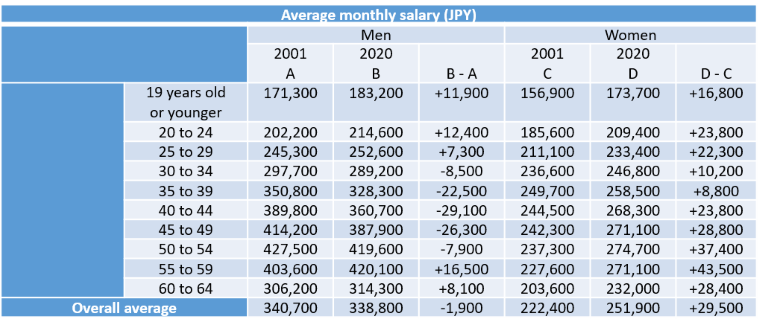Column Finance and the Social Security System 2021.05.18
【Aging, safety net and fiscal crisis in Japan】No.307:The average monthly salary of Japanese workers increased by only 0.6% over the last 2 decades
In this column series, Yukihiro Matsuyama, Research Director at CIGS introduces the latest information about aging, safety net and fiscal crisis in Japan with data of international comparison
On March 31, 2021, the Ministry of Health, Labour and Welfare released the wage statistics for 2020. As shown in Figure 1, the average monthly salary of workers increased by only 0.6% from JPY 305,800 (US $ 2,830) in 2001 to JPY 307,700 (US $ 2,850) in 2020. This is because men’s average monthly salary fell by 0.6% from JPY 340,700 (US $ 3,155) to JPY 338,800 (US $ 3,140) during the same period, while women’s average monthly salary increased by 13.3% from JPY 222,400 (US $ 2,060) to JPY 251,900 (US$ 2,330). Among men, the decrease in average monthly salaries was largest for those in the 35–49-year group (Table 1), which is significant, because this is often the age group that faces most challenges in terms of children’s education costs and mortgage repayments.
The OECD released data revealing that Japanese people have not felt wealthy in the last two decades. In 2001, Japan’s GDP per capita was US$ 27,476, which was higher than the average among OECD countries (US$ 25,417) (Figure 2). However, by 2019, Japan’s GDP per capita was US$ 42,386, which was below average (US $ 46,484). In fact, although Japan’s GDP per capita was about 40% higher than that of South Korea (US $ 19,714) in 2001, it was overtaken by South Korea (US $ 42,723) in 2019.
Figure 1 Historical trend of average monthly salaries in Japan

Source: Ministry of Health, Labour and Welfare.
Table 1 Average monthly salary by age group and gender

Source: Ministry of Health, Labour and Welfare.
Figure 2 GDP per capita

(Source: OECD database)
